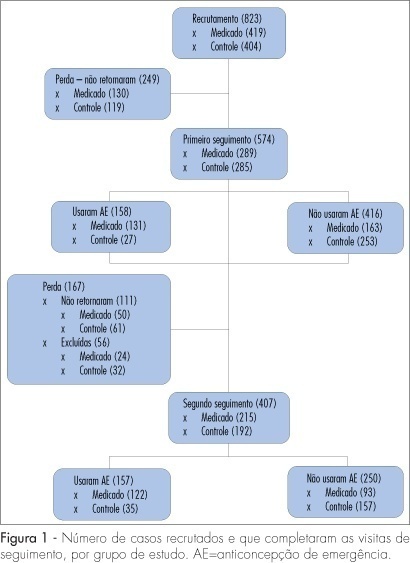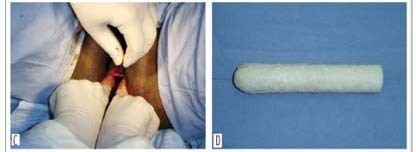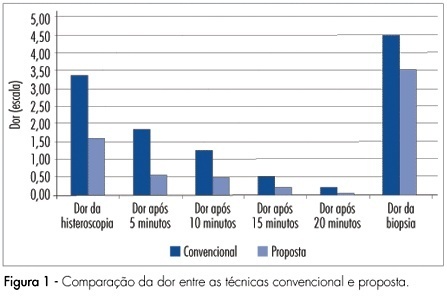Summary
Revista Brasileira de Ginecologia e Obstetrícia. 2008;30(2):67-74
DOI 10.1590/S0100-72032008000200004
PURPOSE: to compare the epidemiologic and clinical characteristics, and the follow-up of breast cancer in women diagnosed under and over 40 years of age. METHODS: a retrospective study, case-control type, with analysis of information obtained from medical records of patients attended from January 1994 to June 2004. Cases of intraductal carcinoma and at stage IV were excluded. Three groups were formed: patients under 40 years old at the diagnosis (n=72); patients between 40 and 50 (n=68) and patients over 50 (n=75). Data about age at the moment of diagnosis, lesion largest diameter, clinical stage, type, histological grade, presence of hormonal receptors and state of the lymph nodes were collected and analyzed. The chi2 test was used for qualitative variables. For quantitative variables without normal distribution (such as number of axillary nodes with metastasis and follow-up duration), the Kruskal-Wallis' test was used. For delineating the curves of free-of-disease and global survival, the log-rank test was used. RESULTS: there was no difference among the groups in the stage distribution, concerning the tumoral differentiation grade or in the distribution of histological types, and in the estrogen receptor and c-erb-B2 expression. Difference was found in the RP expression, which was less frequent in the group of patients under 40, than in the group of patients over 50 (36.2% versus 58.4%) respectively. There was no difference among the groups in the mean tumoral diameter (5.1, 4.7 and 5 cm, respectively). There was also no difference among the groups, concerning the rate of axillary lymph node metastasis (63.9, 46.9 and 50%, respectively). The average follow-up was 54 months for all the groups. Disease recurrence occurred in 22.6% of patients under 40 years old, in 60% of patients between 40 and 50, and in 22.6% of patients over 50, with a significant difference among groups (p<0.0001). Death caused by the disease was higher among patients under 40 (46.9%) than among patients between 40 and 50 (26.9%) and over 50 (22.6%), p=0.0019. The logistic analysis showed that "age under 40" and the "presence of more than one metastatic axillary node" were independent death risk factors. CONCLUSIONS: age under 40 is an independent risk factor for breast cancer. The traditional prognostic indicators, such as stage, tumoral diameter, axillary involvement and presence of hormonal receptors are not associated with the disease evolution.

Summary
Revista Brasileira de Ginecologia e Obstetrícia. 2008;30(2):61-66
DOI 10.1590/S0100-72032008000200003
PURPOSE: to demonstrate the expression of biomarkers, detected by immunohistochemical techniques in healthy tissues, as well as in preneoplastic and neoplastic lesions of the uterine cervix. METHODS: in order to evaluate the immunohistochemical reactivity of tissues from the uterine cervix to p16 and to type 2 herpes simplex virus (HSV-2), 187 samples of low-grade intraepithelial lesions (LG-IEL) and high-grade intraepithelial lesions (HG-IEL), and of uterine cervix carcinoma were compared with a group of patients without uterine cervix lesions. Statistical analysis was done by the chi2 test for trends. The significance level was alpha=0.05. RESULTS: the reactivity to p16 was assessed showing the following distribution: group without uterine cervix lesions: 56% (24/43), LG-IEL: 92% (43/47), HG-IEL: 94% (43/46), and cancer: 98% (46/47) (p<0.001, linear trend). Concerning the HSV-2: group without uterine cervix lesions: 27% (12/45), LG-IEL: 58% (22/38), HG-IEL: 78% (35/45), and cancer: 59 % (29/49) (p<0.001, linear trend). There was an increase in the reactivity ratio for the two markers in the pathological groups (LG-IEL, HG-IEL and uterine cervix cancer, at p<0.001) compared to controls. There was no significant difference between the LG-IEL and the HG-IEL groups. CONCLUSIONS: a progressive increase of reactivity ratios of the studied immunohistochemical markers as a function of lesion severity was observed.
Summary
Revista Brasileira de Ginecologia e Obstetrícia. 2008;30(2):55-60
DOI 10.1590/S0100-72032008000200002
PURPOSE: to compare two strategies of access to emergency contraception: only information and information with previous delivery of this contraceptive method, and its relationship with the use of this method and the regular use of contraceptives. METHODS: from August 2004 to January 2005, 18 to 49-year-old volunteers, attended at reproductive health clinics from six Brazilian towns were recruited. The subjects were randomly distributed in a group getting information about emergency contraception (Control Group), or in a group getting information about this method and previous delivery of the contraceptive (Medicated Group). Follow-up visits occurred into four and eight months. Person and McNemar's tests were used for the statistical analysis. RESULTS: from the 823 recruited subjects, 407 completed the 8-month-observation period and were the sample analyzed. Most of the subjects (61%) did not use the emergency contraceptive. The subjects from the Medicated Group used more emergency contraceptives (57%) than the ones from the Control Group (18%), and they did it more precociously, concerning the time since the unprotected sexual intercourse. There was a significant increase of regular use of contraceptives among the subjects who used emergency contraceptives in the Medicated Group (88% versus 97%) and a statistically nonsignificant decrease in the Control Group. CONCLUSIONS: information and previous delivery intensified the access and use of emergency contraceptives, and did not reduce the regular use of contraceptives, including condoms.

Summary
Revista Brasileira de Ginecologia e Obstetrícia. 2008;30(1):36-41
DOI 10.1590/S0100-72032008000100007
PURPOSE: to establish whether there is a predictive relationship between the antral follicle count (AFC) on the second day of the cycle and the response pattern in controlled ovarian hyperstimulation cycles for intracytoplasmic sperm injection (ICSI). METHODS: a prospective study developed from May 2004 to May 2005, in which 51 patients aged <37 years old were submitted to assisted reproduction/ICSI in ovarian hyperstimulation protocol with gonadotropin recombinant and gonadotropin-releasing hormone (GnRH) antagonist. A transvaginal ultrasonography was performed on the second day of the cycle, to count the number of follicles measuring 2 to 10 mm, at the beginning of stimulus, data compared with the number of follicles with >15 mm on the day of ovulation triggering, the total number of oocytes retrieved and in metaphases II, the number of good quality embryos transferred and pregnancy rate. The statistical analysis was performed by the t-Student test and the Mann-Whitney test, with statistical significance of 5% (p<0.05). RESULTS: the mean age in the study group was 32.4 years. The AFC average was 7.1, minimum of 1 and maximum of 16. Considering AFC as a main variable, a significant direct correlation was observed with the number of follicles >15 mm on the day of ovulation triggering (p=0.0001), the total number of oocytes retrieved (p=0.0001) and those in metaphases II (p=0.0001). Such correlation between AFC and pregnancy was not observed (p=0.43). There was no significant correlation between AFC and the number of good quality embryos transferred (p=0.081). CONCLUSIONS: AFC on the second day of the stimulated cycle can be used to predict the quality of ovarian stimulation, the number of oocytes retrieved and the number of mature oocytes in in vitro fertilization cycles using GnRH antagonist.
Summary
Revista Brasileira de Ginecologia e Obstetrícia. 2008;30(1):31-35
DOI 10.1590/S0100-72032008000100006
PURPOSE: to evaluate the use of natural latex mold (Hevea brasiliensis) as a modification of McIndoe and Bannister neovaginoplasty in patients presenting Mayer-Rokitansky-Küster-Hauser (MKRH) syndrome. METHODS: we retrospectively included nine patients presenting MKRH syndrome, who had been submitted to McIndoe and Bannister neovaginoplasty modified by the use of natural latex mold. Neovaginal epithelization and depth, coitus occurrence and satisfaction, and surgical complications were evaluated. RESULTS: five weeks after the procedure, eight patients presented an epithelized 7 to 12 cm deep neovagina. There was one case of complete neovaginal stenosis, because of incorrect use of the mold. After at least one year, the others maintained 4 to 8 cm deep neovaginas and capacity for intercourse, with 66.7% satisfaction. One woman presented precocious rectovaginal fistula and late episodes of uretrovaginal fistulae. Two patients presented distal neovaginal stenosis in long-term follow-up. One of these and the patient with fistulae were submitted to a new procedure. CONCLUSIONS: the use of natural latex mold as a modification of classic neovaginoplasty technique allows the creation of neovaginas morphologically and functionally similar to the normal vagina in patients with vaginal agenesis.

Summary
Revista Brasileira de Ginecologia e Obstetrícia. 2008;30(1):12-18
DOI 10.1590/S0100-72032008000100003
PURPOSE: to study the use of medicines by pregnant women during prenatal care in clinics of the national public health system in the city of Natal, Brazil. METHODS: a total of 610 pregnant women between the first and the third trimesters of pregnancy were interviewed in the public clinics of the four sanitary districts of Natal, from May to July 2006. The data were collected by a structured questionnaire, based in use-oriented and medicine-oriented questions. The drugs were classified according to the Anatomical Therapeutic Chemical Classification System (ATC), in agreement with the gestation risk criteria from the Food and Drugs Administration (FDA). The statistical analysis was made by the chi2 test. RESULTS: a total of 1,505 drugs were used, with an average of 2.4 medications per woman. The use of at least one drug was found in 86.6% of the women. The most frequently used drugs were anti-anemics (35.6%), analgesics (24.9%), drugs for gastrointestinal disorders (9.1%) and vitamins (7%). According to the FDA classification, 42.7% belonged to category A risk, 27.1% to category B, 29.3% to category C, 0.3% to category D and none to category X. The use of medicines during the first trimester of pregnancy amounted to 43.6%. The rate of drug use increased with higher schooling level and family income. Self-medication was found in 12.2% of the drug intake and this rate was higher in the first trimester of gestation and with women with low education level and previous gestations. CONCLUSIONS: pregnant women from Natal are being exposed to a variety of medicines with uncertain safety in pregnancy. Therefore, more careful prescription is needed, to avoid possible fetal damage.

Summary
Revista Brasileira de Ginecologia e Obstetrícia. 2008;30(1):5-11
DOI 10.1590/S0100-72032008000100002
PURPOSE: to study the value of Doppler velocimetry of the ductus venosus, between the 11th and 14th weeks of pregnancy, associated to the nuchal translucency thickness measurement, in the detection of adverse fetal outcome. METHODS: a transversal and prospective study in which a total of 1,268 fetuses were studied consecutively. In 56 cases, a cytogenetic study was performed on material obtained from a biopsy of the chorionic villus and, in 1,181 cases, the postnatal phenotype was used as a basis for the result. In addition to the routine ultrasonographic examination, all the fetuses were submitted to measurement of the nuchal translucency thickness and to Doppler velocimetry of the ductus venosus. Aiming at prevalence and accuracy indices, sensitivity, specificity, positive predictive value, negative predictive value, probability of false-positive, probability of false-negative, reason of positive probability and reason of negative probability were calculated and analyzed. RESULTS: from the total of 1,268 fetuses, 1,183 cases were selected for analysis. From this number, 1,170 fetuses were normal (98.9%) and 13 fetuses presented adverse outcome at birth (1.1%), including fetal death (trisomy 21 and 22) in two cases; genetic syndrome (Nooman) in one case; two cases of polymalformed fetuses; cardiopathy in three cases; and other structural defects in five cases. The prevalence of the modified ductus venosus (wave A zero/reverse) in the studied population was of 14 cases (1.2%), with a false-positive rate of 0.7%. CONCLUSIONS: there is a significant correlation between the alteration of the ductus venosus Doppler velocimetry and the thickness of the nuchal translucency as an ultrasonographic marker for the first trimester of gestation, in the detection of adverse fetal outcome, especially serious malformations. The ductus venosus was able to diminish the false-positive result in comparison to the isolated use of the nuchal translucency thickness, improving considerably the positive predictive value of the test.
Summary
Revista Brasileira de Ginecologia e Obstetrícia. 2008;30(1):25-30
DOI 10.1590/S0100-72032008000100005
PURPOSE: to compare diagnostic hysteroscopy through vaginoscopy, using warm saline solution, with traditional technique, regarding to pain, patient satisfaction and feasibility of the procedure. METHODS: randomized clinical trial, involving 184 women, referred for diagnostic hysteroscopy, between May and December of 2006. Participants were randomized to be submitted to hysteroscopy by the proposed technique, which consisted of access through vaginoscopy using normal saline at 36ºC as distension medium, no speculum or cervical grasping, or by the traditional technique with CO2. In both techniques, a 2.7 mm hysteroscope was used. Pain was assessed by the analogical visual scale, during the procedure and every five minutes after it. RESULTS: the mean pain score was 1.60 in the proposed technique and 3.39 in the traditional technique (p<0.01). Lower pain scores were also observed after 5, 10 and 15 minutes (p<0,01) as well as after 20 minutes (p=0.056). In the proposed technique, 82.4% of the procedures were feasible, while, in the traditional technique, 84.9% were so (p=0.64). Satisfaction with the procedure was referred by 88.7% of women submitted to the proposed technique and by 76.3% of women submitted to the traditional technique (p<0.05). CONCLUSIONS: diagnostic hysteroscopy by the proposed technique resulted in less pain, same feasibility and greater satisfaction of patients.
